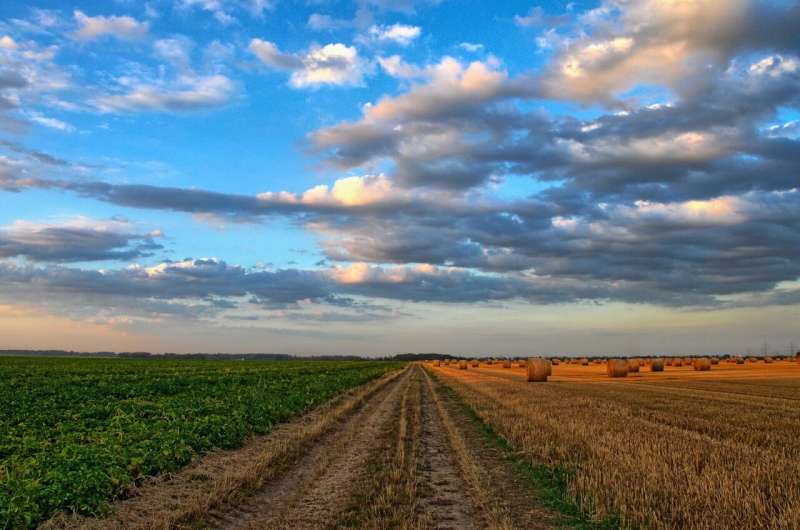
The intensification of existing farmland can sometimes be more harmful to local biodiversity than expanding the area covered by agricultural land, finds a new study led by University College London (UCL) researchers.
They showed that neither expansion nor intensification is consistently better for biodiversity, as it varies by factors including region, crop type and local vegetation.
The findings, published in Nature Ecology & Evolution, challenge the conventional wisdom in favor of intensification, which encourages farmers to improve the productivity of existing farmland with techniques such as increased fertilizer and pesticide use.
Lead author Dr. Silvia Ceaușu (UCL Center for Biodiversity & Environment Research, UCL Biosciences) said, “Feeding the global human population comes at an increasing cost for our planet’s biodiversity. To mitigate this, the common assumption is that intensifying agricultural practices is always less detrimental to biodiversity than farmland expansion.
“But our new research highlights that it’s actually more complicated than that. We show that farmland expansion is indeed drastically changing local biodiversity. However, once agriculture is established, intensifying agricultural practices can further degrade local biodiversity, sometimes more so than by further removing natural vegetation from the area.
“Our findings suggest that closing ‘yield gaps’—maximizing production on existing agricultural land in a given area—could come at a higher ecological cost than previously thought.”
The researchers conducted a global assessment of the impacts on biodiversity from farmland intensification or expansion, using a large biodiversity database, natural vegetation data, and agricultural yield estimates.
They looked at existing agricultural areas (with varying amounts of natural vegetation near the farms; natural areas without any agriculture were excluded) producing maize, soybean, wheat, and rice, four common crops that together represent over half of the total global calorie production.
To measure biodiversity, the scientists looked at species richness (how many different species are in an area), total abundance (how many individuals there are of each species) and the geographical distribution of each species, and they looked at this both in the agricultural area and the surrounding areas.
The researchers found that overall, increasing crop yields by either route is harmful to biodiversity. But as for whether expansion or intensification was more or less harmful, it varied depending on the context, in terms of the region, crop type, or characteristics of the remaining natural vegetation, as well as which measure of biodiversity was used.
The study authors say their findings could have relevance to global agricultural policies and trade initiatives, particularly those aimed at curbing deforestation, as some have requirements for crops to come only from established farmland, which the researchers say may be an oversimplification of the evidence.
While the data are very complex to determine in which situations expansion or intensification is less harmful, they suggest that farmers could at least focus on sustainable intensification techniques, such as biological pest controls and keeping patches of natural vegetation between fields.
For consumers, given the complexities involved in determining the sustainability of different products, the researchers suggest reducing food waste and meat consumption.
Co-author Professor Tim Newbold (UCL Center for Biodiversity & Environment Research, UCL Biosciences) said, “Finding the most sustainable way to increase crop yields is very complicated and depends on numerous factors, so simple suggestions like favoring farmland intensification over expansion are not always effective—there’s no one-size-fits all solution for sustainable agriculture.”
The researchers caution that their study only looked at existing agricultural areas, and does not suggest that cultivating natural areas would be appropriate.
“We would not suggest expanding farmland into intact natural areas as it is vital for the planet that such unmodified landscapes are preserved,” added Dr. Newbold.
Co-author David Leclère (International Institute for Applied Systems Analysis, Austria) said, “In order to protect biodiversity while meeting food demand, we may need to rethink how we balance expansion and intensification in agriculture. There is likely a balance that can be struck between intensification and expansion in agricultural landscapes, informed by local and crop-specific data and considering the full range of environmental impacts.”
More information:
Silvia Ceaușu et al, Geography and availability of natural habitat determine whether cropland intensification or expansion is more detrimental to biodiversity, Nature Ecology & Evolution (2025). DOI: 10.1038/s41559-025-02691-x
Provided by
University College London
Citation:
Intensifying farmland can sometimes be worse for biodiversity than agricultural expansion, study finds (2025, May 2)
retrieved 4 May 2025
from https://phys.org/news/2025-05-farmland-worse-biodiversity-agricultural-expansion.html
This document is subject to copyright. Apart from any fair dealing for the purpose of private study or research, no
part may be reproduced without the written permission. The content is provided for information purposes only.

